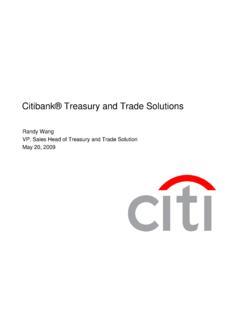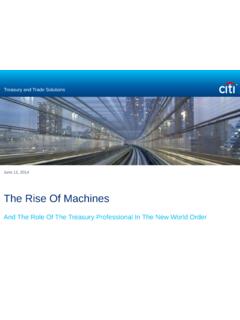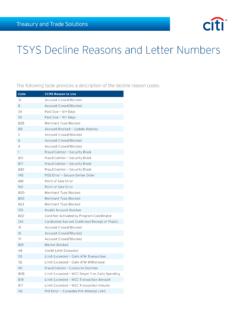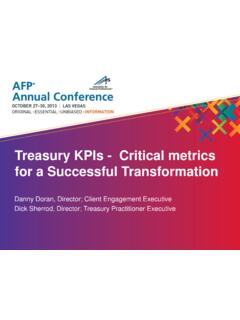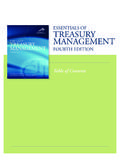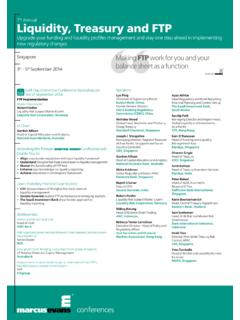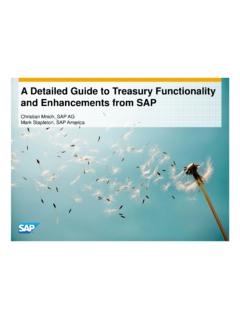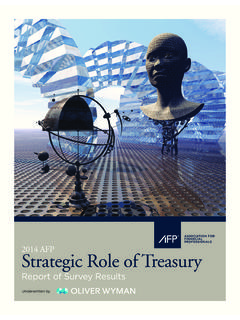Transcription of Citi and Zanders 2016 Treasury and Cash Management ...
1 Citi and Zanders 2016 Treasury and Cash Management technology survey Background technology has for many years been the critical enabler in corporate Treasury for heightened efficiency, enhanced visibility, greater control and more robust security. At the centre of this are the Enterprise Resource Planning (ERP) and Treasury Management (TMS) systems that companies deploy to manage Treasury processes. In order to gain greater insights into the emerging trends in connection with these systems, Citi Treasury and trade solutions , Treasury Advisory Group and Zanders , Treasury and finance solutions consultants, have jointly undertaken a Treasury and Cash Management technology survey . Citi already regularly surveys key clients on their Treasury activities through its on-going, comprehensive Treasury Diagnostics survey .
2 The purpose of the Treasury and Cash Management survey was to further enrich the Treasury Diagnostics results with more detailed analysis of clients current deployment and future intentions towards these Treasury enablers specifically with regard to ERP and TMS systems. survey demographics The participants of the survey included Treasury professionals and other corporate decision makers operating in companies globally (50% in Europe, 39% in the Americas and 11% in Asia) across a range of industries and business sizes as seen in Exhibit 1. 80% of respondents had a turnover in excess of $2 billion. A further breakdown of this can be found in Exhibit 2. Exhibit 1: survey Participants by Industry Exhibit 2: survey Participants by Sales Turnover Citi and Zanders are pleased to provide the following summary of the findings of this survey .
3 SAP continues to dominate ERP and lead in TMS but rationalisation is high on the agenda The survey revealed that SAP is the most widely used ERP system (70%), followed by the Oracle family of products (33%), and Microsoft (8%). Only 26% of SAP users reported operating on a single instance whereas with the Oracle suite of products, at least 50% of companies had already achieved this level of rationalisation. However, almost one-third (31%) of respondents reported that their organizations are considering migrating from their current ERP system(s) or completing an ERP instance consolidation project. This was most commonly expressed amongst SAP users (91%). In terms of TMS usage, 26% of respondents reported using SAP as their primary platform followed closely by Wall Street Systems (including IT2) with 21% and with FIS/SunGard on 16% (Exhibit 3).
4 It was interesting to note that while overall TMS usage is still quite widely distributed despite the recent acquisitions (IT2 by ION Trading; SunGard by FIS) in this space, of the remainder, Kyriba (8%) and Reval, who were independent at the time of this survey (3%), are now making a significant showing in this market segment. However, we expect to see continued consolidation to a smaller number of vendors in the TMS space going forward. Exhibit 3: Treasury Management System usage Significant challenges with TMS reported Lack of functionality was identified as the most common challenge (46%) among survey respondents with regard to the use of their current TMS; the inability to achieve full integration with an ERP system stood second at 32%.
5 (Exhibit 4). Remembering that 70% of companies responding to this survey reported SAP to be their primary ERP system, 47% of respondents cited integration benefits as the primary reason for adopting the SAP TMS over a non-SAP solution. 26% cited the availability of existing licences as being the principle driver of this. It should be noted that companies with an SAP Unless strategy ( seek to choose SAP unless functionality required is not available) represented just under half of the sample (46%). Exhibit 4: Most common challenges with TMS usage Of those companies using SAP as their TMS, Bank Communication Management (BCM) and Treasury & Risk Management (TRM) were identified as the most commonly utilised modules (71% in each case).
6 SAP s In House Cash (IHC) module, which supports companies operating an in-house bank, was used by 50% of respondents while Cash and Liquidity Management (CLM) was used by 43% of respondents. For IHC users, the primary activities for which this functionality is used are detailed in Exhibit 5 below: Exhibit 5: In House Cash principle activities Cloud-based TMS solutions gaining significant acceptance. The survey also explored the extent to which companies are migrating towards cloud-based technology solutions in Treasury . While only 7% of respondents are currently using cloud-based ERP solutions with a further 30% indicating that they would consider this in the future, 23% of respondents indicated that they are already using cloud-based TMS solutions .
7 Almost 40% indicated they would consider cloud-based TMS solutions in the future, perhaps reflecting the greater proliferation and availability of such systems in the market, as evidenced in Exhibit 3 above, offering a lighter touch , more easily implemented and potentially lower cost alternative to the mainstream providers. The survey also revealed that companies currently with, or intending to use, cloud-based solutions are more likely to use a SWIFT Service Bureau for bank connectivity (45%) than any other method, but perhaps surprisingly, traditional Host to Host (H2H) connectivity remains popular with 35% indicating this would still be their preferred solution. Bank Proprietary methods continue to prevail for bank statement delivery While a third of the companies surveyed reported using SWIFT Channels for receiving bank statements, proprietary channels Electronic Banking and Host to Host remain the most prevalent with around 50% using either or both of these in addition to other channels.
8 It was interesting to note that SWIFT s AL2 product is gaining some modest traction (5%) however the use of SWIFT Service Bureau is much more widespread (28%) in this market segment. SAP s new Financial Services Network (FSN) did not register any users but this capability is still in the early adoption phase. In terms of formats used however, the overwhelming majority (75%) use the SWIFT MT940/MT942 standard with BAI2 (38%) the next most commonly used. As the trend towards adoption of XML 20022 formats within the Common Global Implementation (CGI) framework has gathered pace in line with centralisation and bank rationalisation initiatives, 20% of survey participants are now using CAMT as their statement format. Only 5% of the companies reported using bank proprietary formats.
9 Exhibit 6 provides the range and extent of formats used. Exhibit 6: Formats used for Statement Delivery As the drive has continued for greater efficiency and more focus in particular on receivables Management with Straight Through Processing (STP), it is encouraging to note that 60% of companies reported using core ERP/TMS functionality for automatic bank statement processing and reconciliation or a specific add-on tool for this purpose. Only 22% of companies reported that they are still using manual processes for bank statement reconciliation. That said, bank statement delivery and integration generally are still seen as providing challenges. Lack of end-to-end automation (20%) and inefficient processes (18%) were listed as the primary concerns.
10 Exhibit 7 displays the full range of observations on this topic. Exhibit 7: Statement reconciliation and bank integration concerns. Increasing standardisation in payments processing enabled by SWIFT and ISO 20022 XML adoption It is evident that the continuing drive for standardisation in terms of bank connectivity and formats for payments processes is being enabled by company s adoption of SWIFT channels and the ISO 20022 XML standard. SWIFT channels were identified as being used by 41% of survey respondents (33% SSB; 8% AL2), however this is not exclusive connectivity and Host to Host (53%) or proprietary Electronic Banking systems (48%) are also being used in addition in many cases.

